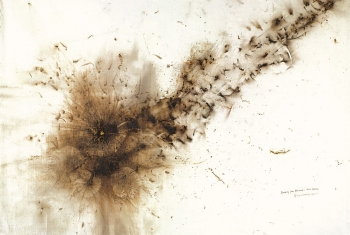PROVENANCE: Albion Contemporary Art, Ltd., London, UK Christie's New York, 13 May 2008, Lot 1 Acquired from the above by the present owner
EXHIBITED: Cai Guo-Qiang: Fuegos Artificiales Negros on Black Fireworks, Institute Valencia d'Art, Mardrid, May 20 - June 12, 2005
ILLUSTRATED: Cai Guo-Qiang: Fuegos Artificiales Negros on Black Fireworks, Institute Valencia d'Art, Mardrid, 2005, color illustrated, p. 178
Catalogue Note:
Among the artists active on the contemporary Chinese art scene, Cai Guo-qiang stands out from the crowd. Born before the Cultural Revolution, Cai was deeply influenced by the cultural and educational influences of the Mao era, but disassociated himself from mainstream thought. Cai’s earliest work, from the early 1980s, does not eulogize the establishment, but neither does it demonstrate any particular opposition to or criticism of the powers-that-be. Cai Guoqiang has always positioned himself as a bystander. Cai once admitted frankly that: “Mao Zedong’s idealism and his attitudes exerted a big influence over all the artists of our generation.” While the work of other artists from Cai’s generation devoted considerable attention to Mao’s image and to the Cultural Revolution, Cai’s art was more personal, softer and more introverted.
Cai Guo-qiang studied stage design in university; on graduation, he was assigned to work with a theatre troupe. As early as 1984, Cai had begun to experiment with the use of a wide range of new materials and new techniques. By the late 1980s, Cai had started using gunpowder and explosion effects in his art. Chinese history, and the development of gunpowder, became a major focus of Cai’s work. The basic constituents of gunpowder are sulfur, charcoal and potassium nitrate; it may also include other elements refined from fertilizer, such as methane. When ignited, the tiny grains of gunpowder explode with immense power. Gunpowder has been used in warfare for centuries; the biggest challenge was getting the proportions of the different constituent elements right when making the powder, so as to ensure that it would explode in the manner required. It was precisely this unpredictability of gunpowder – with different constituent ratios giving different explosive effects – that attracted Cai Guo-qiang. He felt that this characteristic of gunpowder represented a form of spontaneity, something which is lacking in contemporary society. Cai’s background in stage design, and his work experience, also helped him to approach the creation of art from different perspectives. When discussing Cai’s gunpowder explosion pieces, the leading U.S. art critic Dan Cameron offered the following interpretation: “To an artist whose later challenge to the art establishment would consist, at least in part, of his insistence that viewers devote their full attention to an event that was finished in a matter of seconds, the discipline developed through the study of theater is focused on a staged event that nonetheless appears spontaneous to those in the audience. The impresario whose gestural flourish lifts the theatrical curtain is the same as the sculptor of explosions, who lights the fuse and steps away, or the magician who produces a flock of doves from within a pocket handkerchief. In each case, an interlocutor is required first to set the stage, and then to step back and let the human imagination fill in the rest.” (Brief “Blinded by the Light” By Dan Cameron for “Cai Guo-qiang: Head On”, Frankfurt am Main: Deutsche Bank AG, 2006, p. 20) This combination of the planned and the unknown adds an extra touch of mysterious unpredictability to Cai’s explosion art.
In 2003, Cai Guo-qiang was invited to hold a solo exhibition – “Matrix – Firework from Heaven” – at the Berkeley Art Museum in California. Cai designed the installation “Firework from Heaven” specially for the exhibition; the drawing included in this auction is one of the drawings Cai produced when designing the work. “Firework from Heaven” is a large installation that uses modern, multimedia materials – including neon lights and electric charges – to represent traditional Chinese fireworks. In this drawing, Cai Guo-qiang has used his skill at exploding gunpowder on paper to create a truly amazing masterpiece; the marks left by the exploding gunpowder appear just as natural as if black ink had been allowed to run over the paper. The sudden burst of power enters the paper from the upper right-hand side, like a comet blazing across the sky with its long tail trailing behind, creating sparks like radiant dandelions. The complex structure of the flames at the point in time when they burst into existence in the sky seems to reflect the exhibition theme of a ‘Matrix.’ The installation for which this drawing formed part of the design uses modern technology to achieve, through ‘photosynthesis,’ a fleeting, transient sense of the aesthetic beauty of flame; the drawing itself employs masterful composition and image technique to show the exact instant when the gunpowder explodes.
